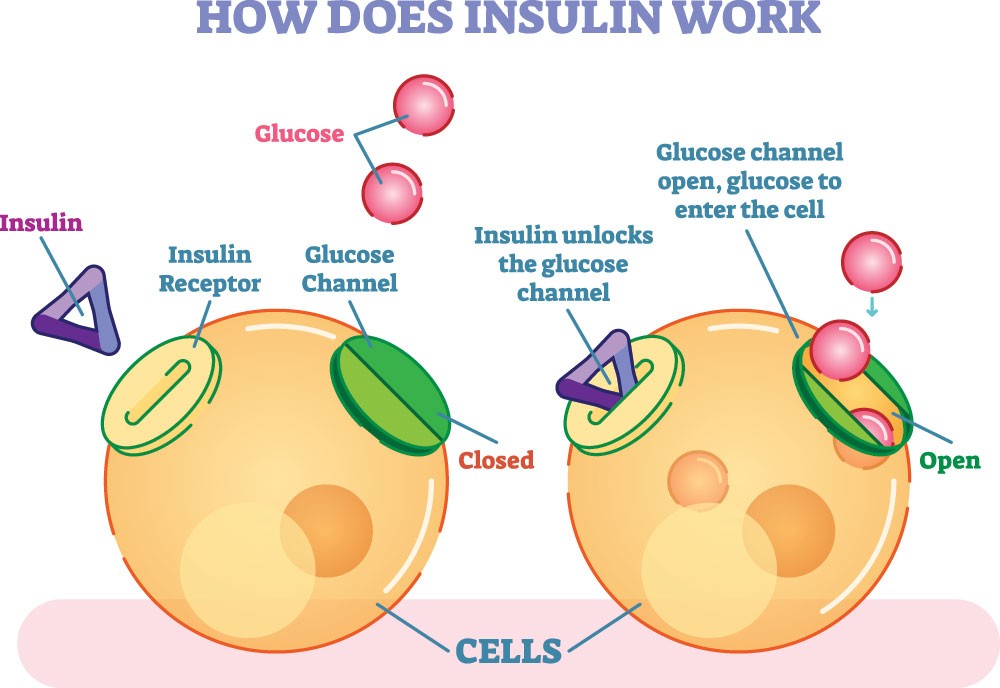Insulin resistance occurs when the body’s cells don’t respond effectively to insulin, leading to elevated blood sugar levels. Unlike diabetes, where insulin production may be insufficient or absent, insulin resistance is often the precursor to type 2 diabetes. The good news is that a well-balanced diet with suitable foods for insulin resistance can significantly improve insulin sensitivity. By focusing on foods that regulate blood sugar and reduce inflammation, you can manage or even reverse insulin resistance.

What Types of Foods Are Suitable For An Insulin Resistance Diet?
A diet tailored for insulin resistance focuses on nutrient-dense foods that help regulate blood sugar, enhance insulin sensitivity, and reduce inflammation. These foods should be rich in fiber, healthy fats, and lean proteins to promote overall metabolic health. Let’s break down the key categories of foods to combat insulin resistance and how they benefit insulin resistance:


Foods to Avoid If You Are Insulin Resistant
The best foods for insulin resistance are the ones that are not processed, fried, refined, or packaged. When managing insulin resistance, it’s not just about the foods you add to your diet but also the ones you should limit or avoid. Certain foods increase insulin resistance, leading to spikes in blood sugar and inflammation. Below are key food categories to steer clear of for better blood sugar control.

What Are The Signs of Insulin Resistance?
Recognizing early signs of insulin resistance is crucial for managing and preventing its progression. Here are some of the key warning signs that are typically caused the consumption of foods that cause insulin resistance:

7-Day Insulin Resistance Diet

A well-balanced diet is key to managing insulin resistance and improving your body’s sensitivity to insulin. This 7-day meal plan provides nutrient-dense foods to control insulin resistance like high-fiber vegetables, lean proteins, healthy fats, and whole grains, helping stabilize blood sugar levels and promote overall metabolic health. Each meal is portioned with calories to guide you towards healthier eating habits while supporting insulin sensitivity.
This diet plan focuses on balanced meals rich in fiber, lean protein, healthy fats, and low glycemic index carbohydrates, which are key to managing insulin resistance.
Conclusion
In conclusion, managing insulin resistance through a well-planned diet can greatly improve your body’s sensitivity to insulin and help prevent the progression toward type 2 diabetes. By prioritizing nutrient-dense foods like vegetables, whole grains, lean proteins, healthy fats, and fiber-rich options, you can regulate blood sugar levels and reduce inflammation. Avoiding processed foods, refined carbs, sugary beverages, and unhealthy fats is equally important in maintaining balanced glucose levels. While insulin resistance can pose serious health risks, dietary changes, along with regular exercise and mindful lifestyle habits, can play a pivotal role in reversing the condition and enhancing overall metabolic health. Making small, consistent adjustments to your meals can significantly impact your health journey and promote long-term wellness.
Read More: Glycemic Index of Milk and Dairy Products
FAQ’s(Frequently Asked Questions)
Foods that repair insulin resistance include leafy greens, cruciferous vegetables, whole grains, and lean proteins. Healthy fats from sources like avocado, nuts, and seeds can also help. These foods are rich in fiber, antioxidants, and healthy fats, which improve insulin sensitivity by reducing inflammation and blood sugar spikes.
Reducing insulin resistance quickly involves adopting a balanced diet with low glycemic index foods, engaging in regular exercise, and managing stress. High-intensity interval training (HIIT) and strength training can improve insulin sensitivity. Additionally, reducing refined carbs and sugars can help lower insulin levels and improve resistance.
Foods that help lower insulin levels include fiber-rich vegetables, whole grains, nuts, seeds, and lean proteins. Omega-3 rich foods like fatty fish and flaxseeds also contribute to better insulin management. Avoiding processed sugars and refined carbohydrates can prevent insulin spikes and maintain stable blood sugar.
Berries, such as blueberries, raspberries, and strawberries, are particularly good for insulin resistance. They are low in sugar and high in antioxidants and fiber, which help regulate blood sugar levels. Apples, pears, and citrus fruits, in moderation, also benefit insulin sensitivity due to their fiber content.
Bananas, especially when consumed in moderation and before fully ripened, can be part of an insulin-resistance-friendly diet. Green or less ripe bananas have resistant starch, which improves gut health and helps manage blood sugar levels. However, it’s essential to pair bananas with protein or healthy fats to avoid blood sugar spikes.
A combination of lifestyle changes, including a balanced diet, regular exercise, and stress management, can help heal insulin resistance. Foods rich in fiber, antioxidants, and healthy fats, along with weight management, contribute to improving insulin sensitivity. Consistent physical activity, especially resistance training, plays a key role in reversing insulin resistance.
The worst foods for insulin resistance include refined sugars, white bread, pastries, sugary beverages, and processed snacks. These foods have a high glycemic index, causing rapid blood sugar spikes and worsening insulin resistance. Trans fats, found in many fried and processed foods, are also detrimental to insulin sensitivity.
Fruits that are high in natural sugars, such as grapes, watermelon, and ripe bananas, can worsen insulin resistance when consumed in excess. These fruits may lead to blood sugar spikes due to their high glycemic index. It’s best to enjoy them in moderation and focus on low-sugar fruits like berries.
Disclaimer
This site provides educational content; however, it is not a substitute for professional medical guidance. Readers should consult their healthcare professional for personalised guidance. We work hard to provide accurate and helpful information. Your well-being is important to us, and we value your feedback. To learn more, visit our editorial policy page for details on our content guidelines and the content creation process.

 English
English












